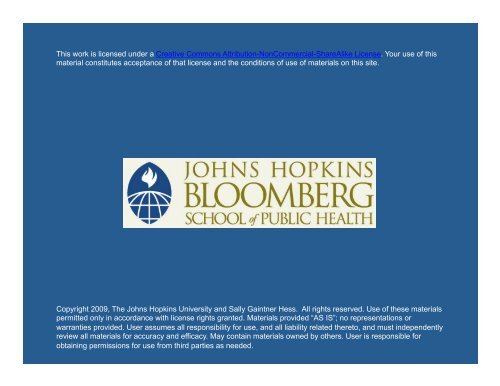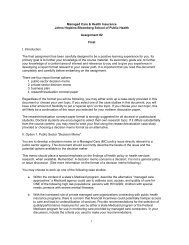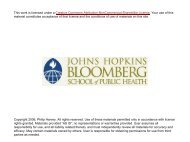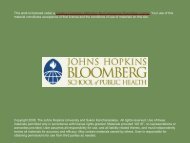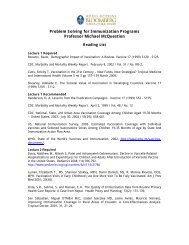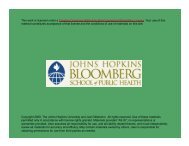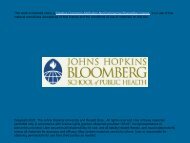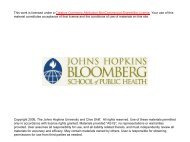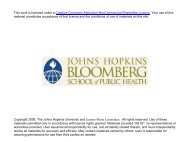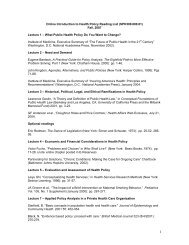Slides - Johns Hopkins Bloomberg School of Public Health
Slides - Johns Hopkins Bloomberg School of Public Health
Slides - Johns Hopkins Bloomberg School of Public Health
Create successful ePaper yourself
Turn your PDF publications into a flip-book with our unique Google optimized e-Paper software.
This work is licensed under a Creative Commons Attribution-NonCommercial-ShareAlike License. Your use <strong>of</strong> this<br />
material constitutes acceptance <strong>of</strong> that license and the conditions <strong>of</strong> use <strong>of</strong> materials on this site.<br />
Copyright 2009, The <strong>Johns</strong> <strong>Hopkins</strong> University and Sally Gaintner Hess. All rights reserved. Use <strong>of</strong> these materials<br />
permitted only in accordance with license rights granted. Materials provided “AS IS”; no representations or<br />
warranties provided. User assumes all responsibility for use, and all liability related thereto, and must independently<br />
review all materials for accuracy and efficacy. May contain materials owned by others. User is responsible for<br />
obtaining permissions for use from third parties as needed.
End-<strong>of</strong>-Life Care:<br />
A <strong>Public</strong> <strong>Health</strong> Call to Action<br />
Sally Gaintner Hess, R.N.<br />
May 9, 2009<br />
Capstone Presentation<br />
Academic & Capstone Advisor:<br />
Dr. George Rebok, Ph.D.
Presentation Outline<br />
� Consider the question: Is EOL care a PH problem?<br />
� Application <strong>of</strong> the Problem-Solving Paradigm<br />
• Problem definition<br />
• Magnitude <strong>of</strong> the problem<br />
• Conceptual framework <strong>of</strong> key determinants<br />
• Identifying and developing strategies<br />
• Setting priorities and recommending interventions<br />
• Implementation and evaluation<br />
• Developing a communication strategy<br />
� Conclusions<br />
� Acknowledgements
If,<br />
Is End-<strong>of</strong>-Life Care<br />
a <strong>Public</strong> <strong>Health</strong> Problem?<br />
<strong>Public</strong> <strong>Health</strong> is what we, as a society, do collectively to assure the<br />
conditions in which people can be healthy. 1<br />
And,<br />
<strong>Health</strong> is a state <strong>of</strong> complete physical, mental, and social well-being<br />
and not merely the absence <strong>of</strong> disease or infirmity. 2<br />
And,<br />
Death has a “universal incidence.” 3<br />
Then,<br />
Shouldn’t we, as <strong>Public</strong> <strong>Health</strong>, ensure health at the end-<strong>of</strong>-life?<br />
1 IOM (1988). The Future <strong>of</strong> <strong>Public</strong> <strong>Health</strong><br />
2 WHO (1948). Preamble to the Cons6tu6on <strong>of</strong> the WHO<br />
3 Rao, JK, et al. (2002). Am J Prev Med, 23, 215-‐200
What Does <strong>Health</strong> at the<br />
CuraNve Care<br />
Diagnosed w/ advanced,<br />
incurable illness<br />
“A Good Death” 1<br />
End-<strong>of</strong>-Life Look Like?<br />
Bereavement Care for Loved Ones<br />
PalliaNve Care<br />
Time<br />
Hospice<br />
esNmated
Call to AcNon<br />
President Obama:<br />
I actually think that the tougher issue<br />
around medical care … is what you do<br />
around things like end-<strong>of</strong>-life care<br />
I think that there is going to have to be<br />
a conversation that is guided by<br />
doctors, scientists, ethicists .<br />
And public health<br />
Leonhardt, D. After the Great Recession. NY<br />
Times Magazine, April 28, 2009
Problem Definition<br />
At present in the United States, at least half <strong>of</strong><br />
all adults experience pain and suffering in the<br />
final months and days <strong>of</strong> their lives at<br />
excessive financial cost and with intense<br />
resource utilization; and these outcomes<br />
ripple out beyond the dying person to their<br />
families, loved ones, caregivers, and<br />
communities.
Magnitude <strong>of</strong> the Problem<br />
• Quality <strong>of</strong> Care: As many as 50% <strong>of</strong> those with cancer or other<br />
terminal illnesses experience unrelieved pain or other symptoms<br />
during their final days. 1<br />
• Cost: Patients with higher costs had worse quality <strong>of</strong> death in their<br />
final week <strong>of</strong> life. 2<br />
• Impact on Families and Caregivers: Being a caregiver who is<br />
experiencing mental or emotional strain is an independent risk factor<br />
for mortality among elderly spousal caregivers. 3<br />
• Access to Services: Despite an overwhelming desire to die at home,<br />
only ¼ <strong>of</strong> Americans die at home. 4<br />
1 Rao, JK, et al. (2002). Am J Prev Med, 23, 215-‐200<br />
2 Zhang, B., et al. (2009). Arch Intern Med, 169, 480-‐488<br />
3 Schulz, R. & Beach, SR. (1999). JAMA, 282, 2215-‐2219<br />
4 Grunier, A, et al. (2007). Medical Care Research Review, 64, 351-‐378.
Conceptual Framework <strong>of</strong><br />
Key Determinants
Identifying and<br />
Developing Strategies<br />
Interven'on Strategies Assessment Assurance<br />
<strong>Public</strong> educaNon �<br />
PaNent, family, & caregiver<br />
educaNon<br />
�<br />
Policy<br />
Development<br />
Pr<strong>of</strong>essional educaNon �<br />
Help for paNents, families, and<br />
453-‐460<br />
�<br />
caregivers<br />
29,<br />
Access to important/support<br />
Med,<br />
�<br />
services<br />
Prev J<br />
Quality <strong>of</strong> services �<br />
Am<br />
Funding and financial issues �<br />
(2005). al.<br />
Policy and planning �<br />
et JK,<br />
Research, epidemiology, and<br />
�<br />
evaluaNon<br />
Rao
Setting Priorities &<br />
Recommending Interventions<br />
� Important role for <strong>Public</strong> <strong>Health</strong><br />
� End-<strong>of</strong>-Life is charged with emotion<br />
� <strong>Public</strong> <strong>Health</strong> can bring<br />
� objectivity,<br />
� methodology, and<br />
� transparency to the process
Implementation and Evaluation
Developing a<br />
Communication Strategy<br />
� How can we communicate with the public<br />
about something nobody wants to talk<br />
about?<br />
� The Viagra model?
Conclusions<br />
� End-<strong>of</strong>-Life care IS a public health problem – we must get involved<br />
� All <strong>of</strong> Us<br />
• Educate ourselves<br />
• Talk about dying<br />
• Be sure that our personal wishes for EOL care are known<br />
� PH Faculty<br />
• Suggest students use EOL as a project topic to apply learning<br />
• Use EOL as examples in your teachings<br />
� PH Practitioners:<br />
• Have you given EOL care consideration in your practice?<br />
Even the Lives <strong>of</strong> the Dying
Acknowledgements<br />
� JHBSPH faculty interviewees:<br />
• Dr. Jane Bertrand<br />
• Dr. Marie Diener-‐West<br />
• Dr. Sydney Dy<br />
• Dr. Andrea Gielen<br />
• Dr. Robert Lawrence<br />
• Dr. George Rebok<br />
• Dr. Holly Taylor<br />
• Mr. William Ward<br />
• Dr. Lawrence Wissow<br />
� My Advisor:<br />
• Dr. George Rebok<br />
• My Family:<br />
• David, Sophie, & Eli Hess<br />
• Sue Gaintner, Wendy Holcomb,<br />
& Jenny Gaintner<br />
This project is<br />
dedicated to my Dad,<br />
Dr. J. Richard Gaintner<br />
1936-‐2004


